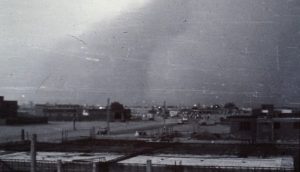37 The Haboobs of Khartoum
While in Khartoum, Sudan, I experienced extreme environmental conditions including intense heat well over 100 degrees Fahrenheit, the annual flooding of the Nile River, and much more. The haboob is a unique experience. The word “habb” is the word for wind in Arabic and the Sudanese have named this gigantic dusty windstorm “haboob”. The most severe haboobs occur during April and May, but minor ones can happen during the rest of the year.
The haboob is generated from Trade Winds that blow west across the planet in the tropical regions. The Trade Wind belt shifts slightly pole-ward through the summer season. The Trades normally bring rain that contribute to the highly vegetated tropical regions. When coming to the Sahel, winds warm and evaporate their moisture while descending from the highlands of Eritrea. The clash between the southwest monsoon and the trade winds create a dry thunder storm which picks up surface material creating a dust storm.

Warm descending winds from the Ethiopian and Eritrean highlands bring only dust. Free map by Maphill. http://www.maphill.com/Maphill Creative Commons Attribution Non-Derivative License (CC BY-ND)
This dry warm wind picks up a lot of material from the desert floor and begins swirling, covering everything with a thin layer of dust. Visibility is three feet amidst the storm. The haboob can be seen in advance as the dust billows up thousands of feet approaching at 20 miles per hour. People go inside when they see it coming and cover things they want to keep clean.
In our house in Khartoum North, the windows were covered with a lattice which did not stop the wind and so the swirly dust covered everything inside. The haboob could last up to four hours. We experienced many of these events during our three years living there. According to “WeatherOnLine.com”, the Sudan experiences an average number of about 24 haboobs every year.
One time my three-year-old twin daughters and I were taking a stroll down to the Blue Nile about a hundred yards from the house. As we walked along, we could see a Haboob coming over the city and I was fascinated watching it advance. Then it occurred to me that it was getting close enough to engulf us, so we started back toward home.
 This haboob was coming toward us as we were out walking along the Blue Nile in Khartoum North. Photo by Rick Bein 1976
This haboob was coming toward us as we were out walking along the Blue Nile in Khartoum North. Photo by Rick Bein 1976
But sure, enough it caught us as we could only walk at the pace of the twins. They were holding my hands, one with the left and the other with the right. As the wind caught up with us we were engulfed with flying dust. We continued on, only able to see three feet in front of us. The twins began to cry about the sand getting into their eyes. I did not experience the same thing. They began grabbing me about my waist wanting to be picked up. When I picked them up they stopped fretting and then it dawned on me that the dust was thicker and contained more of the heavier sand closer to the ground, while at my head level, it was the lighter weight silt and clay. That was more bearable for me as the girls buried the faces in my shoulders. This experience enlightened me about the nature of Haboobs.
Back at the house, dust was covering everything. Mary had started sweeping, but to no avail! We realized that we needed to cover our noses and mouths with damp cloths to keep from breathing the dust.

